Ipe decking is often lauded for its beauty, durability, and natural resistance to insects and decay. Known as Brazilian walnut, Ipe has become a popular choice for high-end decks and outdoor spaces. However, despite its many benefits there Ipe decking does have some disadvantages that potential buyers should consider.
In this blog post, we will explore these drawbacks to provide a balanced view of this sought-after material.
1. High Cost
One of the most significant disadvantages of Ipe decking is its cost. Ipe is considerably more expensive than many other decking materials, including pressure-treated lumber, cedar, and even some composite options. The high price is due to it being imported all the way from South America, the long growth period of the trees, and the extensive processing required to prepare the wood for use. If you’re on a tight budget, Ipe might not be the most economical choice for your decking project.
That said despite it having a higher initial investment it’s one of the only decking materials proven to last up to 75 years on harsh commercial applications such as the Coney Island boardwalk. If you are able to make the higher initial investment you will have a long lasting deck material.
2. Labor-Intensive Installation
Ipe is an extremely dense hardwood, which makes it challenging to work with. Standard tools used for softer woods may not suffice, and specialized equipment is often required. Drilling holes for screws and cutting boards can be time-consuming and labor-intensive. This increased effort translates into higher labor costs if you hire professionals to install your deck. Even if you’re a seasoned DIY enthusiast, be prepared for a more demanding project than usual.
3. Maintenance Requirements
While Ipe is renowned for its durability, maintaining its aesthetic appeal requires regular upkeep. Without proper care, Ipe can lose its rich color and turn a silver-gray patina over time. To preserve its original look, you’ll need to apply a UV-blocking oil finish at least once a year.
Some homeowners prefer the grey look in that case Ipe is the ultimate low maintenance decking option. It does still need to be cleaned just like concrete patios or composite decks as pollen and dirt and rain tend to dirty all those surfaces. A light power wash or DeckWise deck cleaner and a hose will do the job.
Below is a picture of a grey Ipe deck which unlike most woods once it weathers Ipe remains smooth. You can still see the beautiful wood grain and it doesn’t splinter like pressure treated would.

4. Fasteners
Dense South American hardwoods like Ipe require all stainless steel fasteners. Using regular steel fasteners even the coated ones can cause black oxidation stains on the wood around the fasteners which look unsightly. Regardless of the stains since the decking is known to last up to 75 years you should use fasteners that can last a long time without rusting and corroding. Use 316 stainless steel if you are close to saltwater.
5. Weight and Structural Considerations
Ipe is one of the heaviest woods available, which means that your deck’s supporting structure must be robust enough to handle the extra weight. This might require additional framing and support, adding to the overall cost and complexity of the project. The weight can also make handling and transporting the wood more difficult, potentially leading to increased shipping costs and logistical challenges.
In addition to structural weight concerns there are structural lifespan concerns due to the fact that Ipe can last up to 75 years. We’ve received many calls from customers that purchased their Ipe deck from us 15 – 20 years ago and say their Ipe still looks like new however their pressure treated framing is rotting and the deck needs to be torn apart and rebuilt.
The newer pressure treated lumber does not appear to last as long as the old pressure treated wood that contained arsenic. As a result we’ve started offering steel deck framing which is known to last 50+ years.
If you’re building a deck with decking that can last upwards of 75 years it’s a good idea to have a deck frame that has a similar lifespan. This does come as an added cost but it’ll likely be the last deck you’ll ever need which sure beats paying to have a deck built two or three times in your lifetime.
6. Availability Issues
Due to its popularity and the limited regions where it is harvested, Ipe can sometimes be hard to find. Long lead times and potential supply shortages can delay your project and increase costs. Additionally, inconsistencies in supply can result in variations in color and grain pattern, which might affect the overall appearance of your deck.
These issues can be avoided by ordering from AdvantageLumber.com as we are the largest importer in the United States with 4 warehouses spread through the USA. We have the largest inventory and offer free shipping on many orders directly to your home.
7. Ventilation
Being that Ipe is a natural wood it does expand and contract slightly with seasonal temperature and humidity changes which is no different than most building materials. Recommend an Ipe deck to have a minimum of 18″ of ground clearance underneath the deck with plenty of open ventilation.
We’ve seen decks built closer to the ground with all sides of the deck blocked off with skirting. This creates a humidor under your deck so the back of the deck boards are absorbing more humidity then the top of the deck boards which are exposed to open air and sun.
Anytime you have this scenario the face of the deck board and the backside are trying to expand and contract at different rates which causes undesirable movement such as cupped deck boards or even buckled deck boards in some cases.
Conclusion
Ipe decking offers many advantages, including unmatched durability, lifespan and natural beauty. However, the high cost, labor-intensive installation, maintenance requirements, special fasteners, weight, availability issues, and ventilation are important factors to consider. By weighing these disadvantages against the benefits, you can make a more informed decision about whether Ipe is the right choice for your decking project.
If the drawbacks seem too significant, exploring other high-quality decking materials might lead you to a better-suited option for your needs. On the other hand many are drawn to to incredibly long lifespan and the fact that a little maintenance can keep your deck looking like new for decades.
